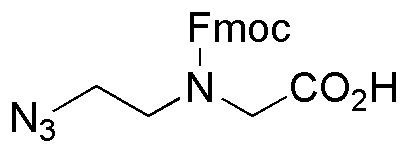Fmoc-N-(2-azidoethyl)glycine is widely utilized in research focused on:
- Peptide Synthesis: This compound serves as a building block in the synthesis of peptides, particularly in solid-phase peptide synthesis, where its protective Fmoc group allows for selective deprotection and functionalization.
- Bioconjugation: The azide group enables click chemistry applications, allowing researchers to easily attach biomolecules, such as proteins or nucleic acids, to surfaces or other molecules, enhancing drug delivery systems.
- Drug Development: It plays a crucial role in the design of novel therapeutics, particularly in the development of peptide-based drugs that require specific modifications for improved efficacy and targeting.
- Material Science: Used in the creation of functionalized polymers, it helps in developing advanced materials with tailored properties for applications in coatings, adhesives, and sensors.
- Diagnostics: The compound can be utilized in the development of diagnostic tools, where its ability to form stable conjugates with biomolecules aids in the detection of diseases through targeted imaging techniques.
General Information
Properties
Safety and Regulations
Applications
Fmoc-N-(2-azidoethyl)glycine is widely utilized in research focused on:
- Peptide Synthesis: This compound serves as a building block in the synthesis of peptides, particularly in solid-phase peptide synthesis, where its protective Fmoc group allows for selective deprotection and functionalization.
- Bioconjugation: The azide group enables click chemistry applications, allowing researchers to easily attach biomolecules, such as proteins or nucleic acids, to surfaces or other molecules, enhancing drug delivery systems.
- Drug Development: It plays a crucial role in the design of novel therapeutics, particularly in the development of peptide-based drugs that require specific modifications for improved efficacy and targeting.
- Material Science: Used in the creation of functionalized polymers, it helps in developing advanced materials with tailored properties for applications in coatings, adhesives, and sensors.
- Diagnostics: The compound can be utilized in the development of diagnostic tools, where its ability to form stable conjugates with biomolecules aids in the detection of diseases through targeted imaging techniques.
Documents
Safety Data Sheets (SDS)
The SDS provides comprehensive safety information on handling, storage, and disposal of the product.
Product Specification (PS)
The PS provides a comprehensive breakdown of the product’s properties, including chemical composition, physical state, purity, and storage requirements. It also details acceptable quality ranges and the product's intended applications.
Certificates of Analysis (COA)
Search for Certificates of Analysis (COA) by entering the products Lot Number. Lot and Batch Numbers can be found on a product’s label following the words ‘Lot’ or ‘Batch’.
Número de catálogo
Número de lote/lote
Certificates Of Origin (COO)
This COO confirms the country where the product was manufactured, and also details the materials and components used in it and whether it is derived from natural, synthetic, or other specific sources. This certificate may be required for customs, trade, and regulatory compliance.
Número de catálogo
Número de lote/lote
Safety Data Sheets (SDS)
The SDS provides comprehensive safety information on handling, storage, and disposal of the product.
DownloadProduct Specification (PS)
The PS provides a comprehensive breakdown of the product’s properties, including chemical composition, physical state, purity, and storage requirements. It also details acceptable quality ranges and the product's intended applications.
DownloadCertificates of Analysis (COA)
Search for Certificates of Analysis (COA) by entering the products Lot Number. Lot and Batch Numbers can be found on a product’s label following the words ‘Lot’ or ‘Batch’.
Número de catálogo
Número de lote/lote
Certificates Of Origin (COO)
This COO confirms the country where the product was manufactured, and also details the materials and components used in it and whether it is derived from natural, synthetic, or other specific sources. This certificate may be required for customs, trade, and regulatory compliance.

